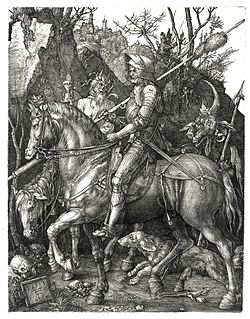
Maximilian armour is a modern term applied to the style of early 16th-century German plate armour associated with, and possibly first made for the Emperor Maximilian I. The armour is still white armour, made in plain steel, but it is decorated with many flutings that may also have played a role in deflecting the points and blades of assailants and increasing the structural strength of the plates. [1] It is a transitional stage in the decoration of armour, after the plain steel surfaces of 15th-century armour and before the elaborate decoration and colouring with etching and other techniques of Renaissance armour. The armour is characterized by armets and close helmets with bellows visors; small fan-shaped narrow and parallel fluting—often covering most of the harness (but never the greaves); etching; work taken from woodcuts; sharply waisted cuirasses, and squared sabatons.
Contents
- Transitional Schott-Sonnenberg style
- Italian "alla tedesca" (a la German) armour
- Parallels with late (rounded) kastenbrust armour
- Maximilian armour and fluted armour
- Gallery
- See also
- References
According to an alternative version, the name is related to Maximilian II, as the last Maximilian armour was made especially for him in 1557, seventeen years after it passed out of general use. [2]
The armour was designed to imitate the pleated clothing that was considered fashionable in Europe at the time. Some armour combined long pleat-like fluting with lines of rectangular shapes imitating contemporary fabrics decorated with slashing or quilting. A trend that developed in 15th and especially 16th-century Europe was to create armour that not only provided the maximum amount of protection, but was also visually pleasing. Maximilian armour combined the rounded Italian style of armour with the German fluted style.
Not every armour worn by Maximilian I was Maximilian-style armour. The most famous armour worn by Maximilian was Gothic-style armour, which was worn by Maximilian when he was a young prince and later presented as an honourable wedding gift for his uncle Sigmund. [3] Maximilian I became emperor in 1493 and died in 1519, but classic Maximilian armour is known from 1515 to 1525, and similarly shaped armour with less or different fluting was produced from 1500. [4] Surviving pieces bearing the mark of the Nuremberg armourer Valentin Siebenbürger (fl. c. 1510 – c. 1564) show that fully developed fluted field armour was still being produced into the early 1530s, more than a decade after Maximilian I's death. At least 36 of Siebenbürger's works, ranging from complete harnesses to isolated breastplates, gauntlets, and crinets, are now preserved in museum collections across Europe and North America. [5]










